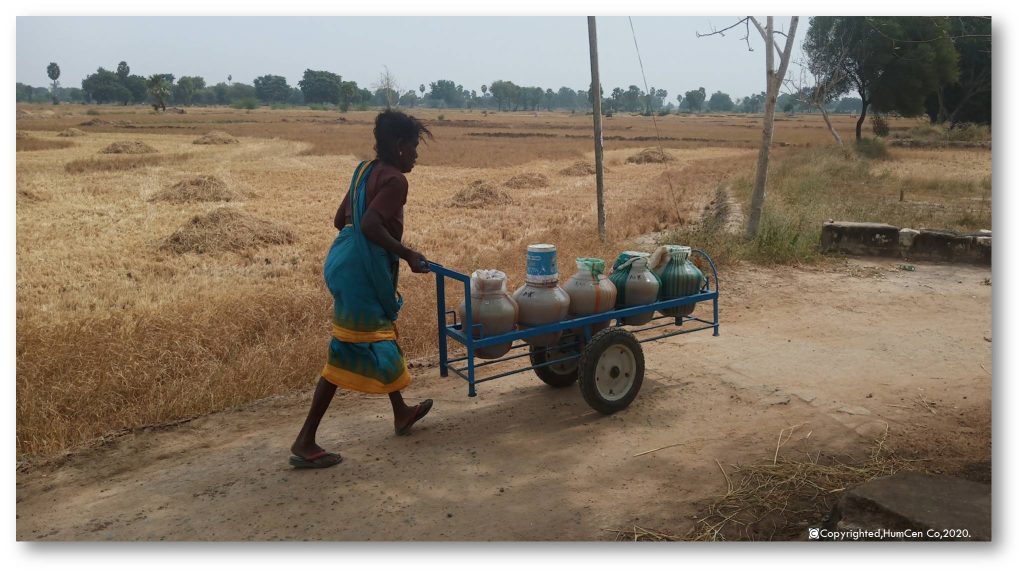A Magical Approach of HCD-A Case Study Example!

A Magical Approach Of Human Centred Design: Case Study Of Water Carrying Handcart.
Human-centred design is a philosophy to think differently. It only applied for modern-day technical innovations but it exists since the inception of human civilization. Whether it’s an invention of the wheel or farming, Human-centred design is the best way to approach a reallife problem. Have you ever wondered why the human-centric approach results in a successful product or a successful business? Why it’s the best design philosophy?
The answer is simple, Designers or inventors don’t invent things in a reference of the abstract that doesn’t exist, they design for humans! The common good is human-centric. There is a whole lot of difference between ‘a mere problem-solving skill’ and ‘a human-centric approach of problem-solving’. One of the biggest problems faced by the world and especially in India is ‘Water scarcity’. The problem in itself is vast and has a different face in various parts of the world.
In India, nearly hundreds of millions of people are affected every year directly or indirectly. Drying reservoirs either completely or far below average in summer is a common scene across the nation. Water scarcity in the city of Chennai has picked wide attention. In mid-summer, Chennai taps were running completely dry. In the same year, many north and central Indian regions faced water scarcity issues. Though the ‘Water scarcity’ is real but managerial problems were completely different in both places. In Urban areas, the best possible solution in a coastal city like Chennai is entirely different from a hilly town like Manali.
Rural Scenario is completely different from both of these situations. So, defining ‘Water Scarcity’ as a problem is the biggest problem in itself. An engineer or an inventor might think of designing a complex water conveyance system or a costlier irrigation project sitting in the office, but will it be the right approach to solve the issue? Let’s not focus on the end solution, it might be the best solution or might not! Definitely, It’s not the right approach. The best possible approach is to observe the people who are facing the problem.
Demographics of area, rural economy, daily activities, and their water requirements. Urban and rural areas are heavily dependent on groundwater and nearby reservoirs. Requirements in urban areas are completely different than rural areas in terms of conveyance, quality, and application. A large percentage of water in urban areas is used for industrial and domestic purposes while
agriculture consumes more in rural areas.
A woman and children carrying the stack of crocks and walking barefoot for miles are often observed during summers. Management of daily water needs is the most time consuming and tedious job for rural women. To carry water overhead not only consumes time but also impacts health. The vast problem of ‘Water Scarcity’ is now shortened to women, who are facing it in day to day life. Why ‘water scarcity’ is directly hitting rural women and children? The most obvious reason is ‘time and effort’ spent on it. This time could be utilized for various activities that support the rural economy. Time saved can also be utilized by children to improve their academics and sports. The designer’s job here is to save time and efforts taken by them!

The picture ‘woman carrying the handcart’ is taken in a village of Tamil Nadu. It’s an example of a perfect user-centric approach. This cart is widely popular in the water-scarce regions of Tamil-Nadu. A single woman who used to carry one or two jars of water in a single trip now brings 4 to 5 times more water in much less effort. A hand cart is designed to carry jars of different shapes and sizes very comfortably. It’s provided with two wheels and supports to improve the speed. A cart is also provided with a handle at a suitable height and angle which helps them to drive the cart with minimal efforts.
The handcart is so popular that it has been often gifted in rural marriages. Just like they name their cattle, they also name their cart. Overall, It’s part of their culture! Why the cart is strongly connected to their hearts! The cart is not run by advanced technology and it’s not even rocket science! It just works like magic! Beyond its utility, it elevates their quality of life. A simple handcart changed the
experience of work which used to be tedious and harsh.
Humcen, a global human-centered design company honors effort taken by designers and inventors to create a user-centric design. Humcen is open to collaboration with academicians, industries, and start-ups for co-creation. It also provides end to end consultation for design and fast-track patenting. Don’t forget to check out our website!

